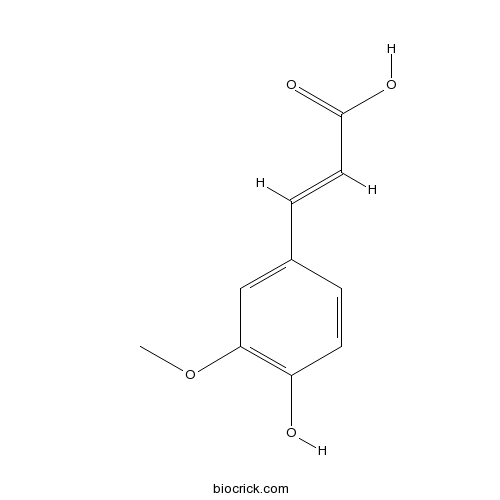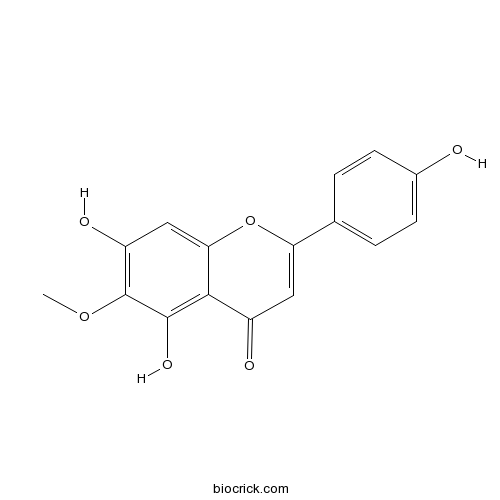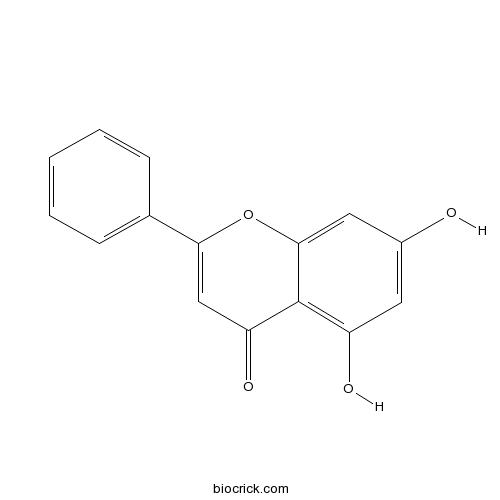Erigeron annuus
Erigeron annuus
1. The products in our compound library are selected from thousands of unique natural products; 2. It has the characteristics of diverse structure, diverse sources and wide coverage of activities; 3. Provide information on the activity of products from major journals, patents and research reports around the world, providing theoretical direction and research basis for further research and screening; 4. Free combination according to the type, source, target and disease of natural product; 5. The compound powder is placed in a covered tube and then discharged into a 10 x 10 cryostat; 6. Transport in ice pack or dry ice pack. Please store it at -20 °C as soon as possible after receiving the product, and use it as soon as possible after opening.
Natural products/compounds from Erigeron annuus
- Cat.No. Product Name CAS Number COA
-
BCN5948
Ferulic acid1135-24-6
Instructions

-
BCN6250
Hispidulin1447-88-7
Instructions

-
BCN5557
Chrysin480-40-0
Instructions

Mowing: A cause of invasion, but also a potential solution for management of the invasive, alien plant species Erigeron annuus (L.) Pers.[Pubmed: 29960189]
Erigeron annuus is one of the major invasive, alien plants in Korea, and therefore research to manage (control) this invasive plant is essential. In this research, studies were conducted to determine the mechanisms by which E. annuus became the dominant plant at a landfill site and to develop management strategies for this alien plant. Because the seeds and seedling stage did not have superior adaptations to disturbed soil, demonstrate allelopathy, outcompete other species, or show rapid growth, the disturbance from mowing was likely the primary reason for the dominance of E. annuus. The areas without mowing showed a significant decrease in the coverage of E. annuus, whereas the mowed (managed) areas showed a significant increase. Additionally, mowing once increased the weight of reproductive organs by 50% and suppressed the growth of native species. Thus, the primary factor in the invasion of the alien species E. annuus was mowing, and, to control such an invasion, areas should be protected from mowing. Additionally, with selective mowing that targeted only E. annuus, mowing three times produced only approximately 10% of the reproductive organ biomass compared with that of the control. Because the flower stalk of E. annuus was relatively tall compared with that of native species in early summer, selective mowing might also provide a solution to control invasions of E. annuus. Therefore, with improved ecological understanding of the site and species, mowing of the right target during the optimal season and at an appropriate frequency is an environmental friendly solution to the management of E. annuus.
Responses of the soil fungal communities to the co-invasion of two invasive species with different cover classes.[Pubmed: 29030899]
Soil fungal communities play an important role in the successful invasion of non-native species. It is common for two or more invasive plant species to co-occur in invaded ecosystems. This study aimed to determine the effects of co-invasion of two invasive species (Erigeron annuus and Solidago canadensis) with different cover classes on soil fungal communities using high-throughput sequencing. Invasion of E. annuus and/or S. canadensis had positive effects on the sequence number, operational taxonomic unit (OTU) richness, Shannon diversity, abundance-based cover estimator (ACE index) and Chao1 index of soil fungal communities, but negative effects on the Simpson index. Thus, invasion of E. annuus and/or S. canadensis could increase diversity and richness of soil fungal communities but decrease dominance of some members of these communities, in part to facilitate plant further invasion, because high soil microbial diversity could increase soil functions and plant nutrient acquisition. Some soil fungal species grow well, whereas others tend to extinction after non-native plant invasion with increasing invasion degree and presumably time. The sequence number, OTU richness, Shannon diversity, ACE index and Chao1 index of soil fungal communities were higher under co-invasion of E. annuus and S. canadensis than under independent invasion of either individual species. The co-invasion of the two invasive species had a positive synergistic effect on diversity and abundance of soil fungal communities, partly to build a soil microenvironment to enhance competitiveness of the invaders. The changed diversity and community under co-invasion could modify resource availability and niche differentiation within the soil fungal communities, mediated by differences in leaf litter quality and quantity, which can support different fungal/microbial species in the soil.
Endophytic Detection in Selected European Herbal Plants.[Pubmed: 29334055]
A total of 181 cultivable endophytic bacterial isolates were collected from stems of 13 species of herbs inhabiting Europe (Poland): Chelidonium majus L., Elymus repens L., Erigeron annuus L., Euphrasia rostkoviana Hayne, Foeniculum vulgare L., Geranium pratense L., Humulus lupulus L., Matricaria chamomilla L., Mentha arvensis L., Papaver rhoeas L., Rosmarinus officinalis L., Solidago gigantea L. and Vinca minor L. The isolates were screened for their antifungal activity and fifty three were found to inhibit fungal growth. Of these, five had strong antifungal properties. These selected isolates were identified as: Pseudomonas azotoformans, P. cedrina, Bacillus subtilis group and Erwinia persicina.
Early-stage changes in natural (13)C and (15)N abundance and nutrient dynamics during different litter decomposition.[Pubmed: 26915037]
Decomposition, nutrient, and isotopic (δ(13)C and δ(15)N) dynamics during 1 year were studied for leaf and twig litters of Pinus densiflora, Castanea crenata, Erigeron annuus, and Miscanthus sinensis growing on a highly weathered soil with constrained nutrient supply using litterbags in a cool temperate region of South Korea. Decay constant (k/year) ranged from 0.58 to 1.29/year, and mass loss ranged from 22.36 to 58.43 % among litter types. The results demonstrate that mass loss and nutrient dynamics of decomposing litter were influenced by the seasonality of mineralization and immobilization processes. In general, most nutrients exhibited alternate phases of rapid mineralization followed by gradual immobilization, except K, which was released throughout the field incubation. At the end of study, among all the nutrients only N and P showed net immobilization. Mobility of different nutrients from decomposing litter as the percentage of initial litter nutrient concentration was in the order of K > Mg > Ca > N ≈ P. The δ(13)C (0.32-6.70 ‰) and δ(15)N (0.74-3.90 ‰) values of residual litters showed nonlinear increase and decrease, respectively compared to initial isotopic values during decomposition. Litter of different functional types and chemical quality converged toward a conservative nutrient use strategy through mechanisms of slow decomposition and slow nutrient mobilization. Our results indicate that litter quality and season, are the most important regulators of litter decomposition in these forests. The results revealed significant relationships between litter decomposition rates and N, C:N ratio and P, and seasonality (temperature). These results and the convergence of different litters towards conservative nutrient use in these nutrient constrained ecosystems imply optimization of litter management because litter removal can have cascading effects on litter decomposition and nutrient availability in these systems.
Classification and identification of metal-accumulating plant species by cluster analysis.[Pubmed: 24888623]
Identification and classification of metal-accumulating plant species is essential for phytoextraction. Cluster analysis is used for classifying individuals based on measured characteristics. In this study, classification of plant species for metal accumulation was conducted using cluster analysis based on a practical survey. Forty plant samples belonging to 21 species were collected from an ancient silver-mining site. Five groups such as hyperaccumulator, potential hyperaccumulator, accumulator, potential accumulator, and normal accumulating plant were graded. For Cd accumulation, the ancient silver-mining ecotype of Sedum alfredii was treated as a Cd hyperaccumulator, and the others were normal Cd-accumulating plants. For Zn accumulation, S. alfredii was considered as a potential Zn hyperaccumulator, Conyza canadensis and Artemisia lavandulaefolia were Zn accumulators, and the others were normal Zn-accumulating plants. For Pb accumulation, S. alfredii and Elatostema lineolatum were potential Pb hyperaccumulators, Rubus hunanensis, Ajuga decumbens, and Erigeron annuus were Pb accumulators, C. canadensis and A. lavandulaefolia were potential Pb accumulators, and the others were normal Pb-accumulating plants. Plant species with the potential for phytoextraction were identified such as S. alfredii for Cd and Zn, C. canadensis and A. lavandulaefolia for Zn and Pb, and E. lineolatum, R. hunanensis, A. decumbens, and E. annuus for Pb. Cluster analysis is effective in the classification of plant species for metal accumulation and identification of potential species for phytoextraction.
Antimicrobial fabrication of cotton fabric and leather using green-synthesized nanosilver.[Pubmed: 24721085]
This study aims to investigate the green synthesis of silver nanoparticles (AgNPs) by Erigeron annuus (L.) pers flower extract as reducing and capping agent, and evaluation of their antibacterial activities for the first time. The obtained product was confirmed by UV-Vis spectrum, high resolution-transmission electron microscopy, energy-dispersive X-ray spectroscopy, Fourier transform infrared spectroscopy, and X-ray diffraction studies. The optimum AgNPs production was achieved at pH 7, metal silver (Ag(+) ion) concentration of 2.0mM, flower extract concentration 4%, and time 335 min. In addition, the antibacterial activity of cotton fabrics and tanned leather loaded with AgNPs, commercial AgNPs, flower extract, Ag(+) ion and blend of flower extract with AgNPs were evaluated against Gram-positive odor causing bacteria Brevibacterium linens and Staphylococcus epidermidis. The results showed maximum zone of inhibition (ZOI) by the cotton fabrics embedded with blend of flower extract and AgNPs against B. linens. The structure and morphology of cotton fabric and leather samples embedded with AgNPs, Ag(+) ion and blend of flower extract with AgNPs were examined under field emission scanning electron microscope.
Volatiles from intact and Lygus-damaged Erigeron annuus (L.) Pers. are highly attractive to ovipositing Lygus and its parasitoid Peristenus relictus Ruthe.[Pubmed: 23982679]
Trap cropping and biological control can provide a sustainable means of controlling insect pests. Insects in the genus Lygus (Hemiptera: Miridae) are major pests on cotton and horticultural crops throughout the United States, and pesticide resistance within Lygus populations necessitates more sustainable long-term management techniques. Here, we explore behavioral responses of Lygus bugs (L. rubrosignatus Knight) and an introduced parasitoid, Peristenus relictus (Hymenoptera: Braconidae), to a common field edge plant, Erigeron annuus, which has the potential to serve as a trap host. Erigeron annuus is attractive to Lygus in the field, with Lygus preferentially moving to Erigeron patches compared to more abundant cotton plants. To determine the role of odor cues in mediating this attraction, we collected volatiles from E. annuus with and without Lygus damage, and then tested the attractiveness of these volatiles vs. those of cotton to Lygus females and female P. relictus wasps using Y-tube and wind tunnel bioassays. We found that undamaged E. annuus emits high concentrations of a complex volatile blend (60+ compounds), with novel compounds induced and constitutive compounds up-regulated in response to damage. Additionally, both female Lygus bugs and female P. relictus wasps are highly attracted to E. annuus volatiles over those of cotton in almost every combination of damage treatments. Our results suggest that Erigeron annuus would be an effective trap plant to control Lygus in cotton, since it is highly attractive to both the pest and its natural enemy.
Roots of Erigeron annuus Attenuate Acute Inflammation as Mediated with the Inhibition of NF- κ B-Associated Nitric Oxide and Prostaglandin E2 production.[Pubmed: 23533473]
Erigeron annuus is a naturalized plant belonging to Compositae (asteraceae) family, which is called the annual fleabane, and commonly found at meadows and roadside. This study investigated the anti-inflammatory effects of the extract of E. annuus roots (EER), as assessed by the paw edema formation and histological analysis in rat, and the productions of nitric oxide (NO), prostaglandin E2 (PGE2), and pro-inflammatory cytokines in Raw264.7 murine macrophages. Carrageenan treatment promoted infiltration of inflammatory cells and caused swelling in the hind paw. Oral administrations of EER (0.3 g/kg and 1 g/kg) attenuated acute inflammation similar to the result using dexamethasone (1 mg/kg). Treatment of macrophages with lipopolysaccharide (LPS) simulated inflammatory condition: LPS significantly increased the productions of NO, PGE2, and proinflammatory cytokines. EER suppressed activation of macrophages, preventing the induction of iNOS and COX-2 protein expressions. LPS treatment induced phosphorylation of I- κ B α and increased the level of nuclear NF- κ B protein, both of which were suppressed by concomitant treatment of EER. In conclusion, EER ameliorated acute inflammation in rats, and the induction of NO, PGE2, and proinflammatory cytokines in Raw264.7 cells. EER's effects may be associated with its inhibition of NF- κ B activation, suggesting its effect on inflammatory diseases.
[New sesquiterpenoids from the rhizomes of Petasites japonicus MAXIM. and the roots of Ligularia dentata HARA].[Pubmed: 22864346]
Over the past twenty years, our research group has been involved in the phytochemical study of terpenoids from Compositae plants. From seven species, namely, Erigeron annuus (L.) PERS., Erigeron philadelphicus L., Erigeron sumatrensis RETZ., Ligularia dentata HARA, Ligularia stenocephala MATSUM. et KOIDZ., Petasites japonicus MAXIM., and Tussilago farfara L., we isolated 83 new compounds. In this review, structural features of 19 eremophilane-type sesquiterpenoids from rhizomes of P. japonicus and 9 bisabolane-type sesquiterpenoids from roots of L. dentata are discussed.


